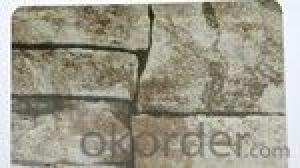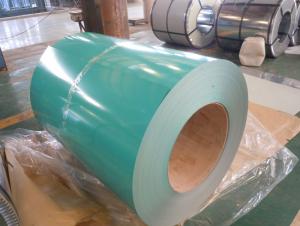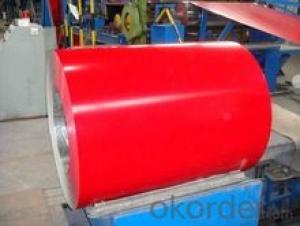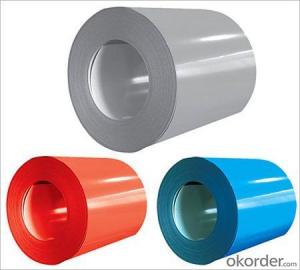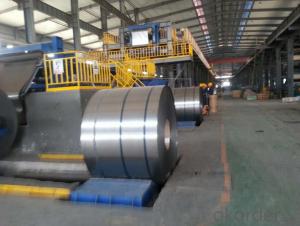Prepainted galvanized steel coil
- Loading Port:
- Tianjin
- Payment Terms:
- TT OR LC
- Min Order Qty:
- -
- Supply Capability:
- 50000 m.t./month
OKorder Service Pledge
OKorder Financial Service
You Might Also Like
Prepainted Galvanized Steel Coil-High Quality
SPECIFICATION:
Product name | Prepainted Galvanized Steel Coil-High Quality |
thickness | 0.35mm—5mm |
width | 600mm—1500mm |
zinc coating | 30g-275g |
Paint Thickness | Top:15-28um, back:5-10um |
Standard | ASTM A792, JIS G3321, JIS G3317, GB |
Material | SGCC/SGCH |
Base Plate | Cold rolled steel sheet, hot dipped zinc coated steel sheet,hot dipped A-Z coated steel sheet |
Surface Paint | PE,PP |
Color Series | RAL color number series |
Equipment | Double coating double baking |
Packing | 1. standard seaworthy package : waterproof paper/iron sheet/steel strip/steel pallet 2. According to customers' requirements |
Coil Wgt. | 3Mt - 8Mt |
Coil ID | φ508mm,φ610mm |
Payment | T/T or L/C |
Min order | 50 tons |
Capacity | 5000Mt/week |
Delivery time | within 40 days upon receipt original L/C or advance payment |
APPLICATION:
1.Buildings and constructions: roofing, ceilings, gutters, venting lines, indoor decorations, window frames, etc
2.Electrical appliances: computer shells, washing machines, refrigerators, dehumidifiers,
video recorders, water heaters, etc.
3. Agricultural equipments: troughs, feeding tools, agricultural driers, irrigation channels, etc.
4. Vehicle parts: back-seat plates of buses and trucks, conveying systems, oil tanks, etc.
- Q: How do steel coils compare to other materials, such as aluminum or copper?
- Steel coils have several advantages over other materials such as aluminum or copper. Firstly, steel is generally stronger and more durable, making steel coils less prone to damage or deformation. Additionally, steel has better heat resistance and can withstand higher temperatures, making it suitable for a wider range of applications. Steel coils also tend to be more cost-effective compared to aluminum or copper, making them a popular choice in various industries.
- Q: What are the different coil cutting methods used for steel coils?
- Various methods are commonly employed for cutting steel coils, each boasting its own unique advantages and applications. Among these techniques are shearing, slitting, and laser cutting. 1. Shearing: By applying substantial force to a set of blades, shearing effectively slices through steel coils in a straight line. This method is highly suitable for reducing the size of thick steel coils into more manageable dimensions. Not only is shearing cost-effective, but it is also well-suited for high-volume production. 2. Slitting: Slitting involves the process of dividing a wide coil into multiple narrower strips. This approach is frequently utilized for steel coils that require various widths, such as those used in the fabrication of automotive components, construction materials, and electrical appliances. Slitting machines utilize circular knives to execute precise cuts, ensuring minimal material loss and achieving high levels of accuracy. 3. Laser cutting: Laser cutting represents a more advanced technique wherein a high-powered laser beam is employed to sever steel coils. This method provides exceptional precision, allowing for intricate designs and complex shapes to be effortlessly cut. Laser cutting is particularly suitable for steel coils of thin to medium thickness and is frequently employed in industries that demand superior cuts, such as automotive, aerospace, and electronics. Each of these coil cutting methods possesses unique merits and is selected based on the specific requirements of the steel coils being processed. Factors including coil thickness, desired accuracy, production volume, and the complexity of required cuts are all taken into consideration when determining the most appropriate cutting method.
- Q: What is the difference between carbon steel and spring steel?? And which is the better one to make swords with??
- High Carbon Spring Steel
- Q: What are the common methods of joining steel coils together?
- Common methods of joining steel coils together include welding, mechanical fastening (such as using bolts or screws), adhesive bonding, and interlocking methods.
- Q: full discription about hydrolics used in steel melting shop with hyd valve is use in thair circit too ?
- The correct spelling is hydraulics. I haven't heard the term steel melting shop you probably means a foundry or a steel mill The most obvious example i can think of is hydraulic-operated fork lifts. Hydraulic cylinders are used to lift the forks and to tilt them upwards or downwards. The valves are coneccted to levers next to the steering wheel. Hydraulic pressure is supplied by a hydraulic pump driven by a propane or diesel engine. In some forklift designs the wheels are also not connected directly to the engine, but driven by hydraulic motors. There are also a large variety of machines used in steel mills and metalworking companies to cut and shape metal parts. for example, press brakes, plate cutting shears, stamping presses, hole punch machines, drawing presses, etc. These types all operate in much the same basic way. They use a very large cylinder or group of cylinders to apply many tons of force to different kinds of metal working tools.
- Q: How are steel coils used in the production of steel containers?
- Steel containers rely heavily on steel coils as a vital component in their production. These coils, made from flat-rolled steel, serve as the foundation for the container's main body. To start the process, the steel coils are unwound and fed into a rolling mill. Here, they undergo a sequence of procedures to shape and mold the steel. One of these steps involves heating the coils to a specific temperature, making them more malleable and easier to manipulate. Subsequently, the hot coils pass through a series of rollers that gradually reduce their thickness and elongate them to the desired size. This entire procedure is referred to as hot rolling. Once the steel coils have been rolled to the necessary thickness, they are then cooled and transformed into sheets. These sheets are further treated to eliminate any imperfections or irregularities, guaranteeing a smooth and even surface. This is accomplished through processes like pickling, where acid is used to remove any scale or rust, and cold rolling, where the sheets are passed through rollers at room temperature to achieve the desired thickness and surface finish. After the sheets have been cleaned and refined, they are molded into the shape of the container. This typically involves a technique known as stamping, in which hydraulic presses are used to press the steel sheets into a mold. The mold determines the container's shape and size, and the steel sheets are pressed against it with great force, resulting in the desired container shape. Once the containers have been formed, they undergo several finishing processes, including welding, painting, and coating. These processes are carried out to enhance the containers' durability, appearance, and resistance to corrosion. These final touches ensure that the steel containers meet the necessary standards and are of high quality for their intended use. In conclusion, steel coils are of paramount importance in the manufacturing of steel containers, as they provide the raw material needed for their production. Through a series of steps, the steel coils are shaped, cut, and formed into sheets, which are then further processed and molded into the desired container shape. The outcome is a robust and dependable steel container suitable for various applications across industries.
- Q: i currently have just steel guitar strings, not a fan they need replacing and i was wondering whats the difference between steel and bronze strings and or nickle strings?
- That depends a lot on what type of music you want to play. Most of the acoustic guitar music you hear on the radio is steel string. That's the bright, sustaining tone most musicians associate with acoustic guitar. Nylon strings give a more muted, mellower tone. Typically this is used for classical playing, although it has been used in popular music very successfully. (Think of Clapton's Tears In Heaven -- the second, lead guitar is a nylon string.) Many people will tell you that a nylon string guitar will be easier to learn on. This is true, but if you go with a classical guitar, with the wider neck and shorter fretboard, you might find some troubles transitioning to the standard longer narrower acoustic fretboard.
- Q: How are steel coils used in the manufacturing of roofing materials?
- Steel coils are used in the manufacturing of roofing materials as they serve as a primary raw material for producing metal roofing sheets and tiles. These coils are processed through a series of steps such as cleaning, coating, and shaping to create durable and weather-resistant roofing products. The steel coils are rolled out and cut into the desired size and shape, ensuring uniformity and precision in the manufacturing process. These roofing materials made from steel coils offer exceptional strength, longevity, and protection against various weather conditions, making them a popular choice for residential and commercial buildings.
- Q: What are the different types of steel coil finishes?
- There are several different types of steel coil finishes, including mill finish, galvanized finish, painted finish, and stainless steel finish.
- Q: What are the different grades of steel used in coil production?
- There are various grades of steel used in coil production, including low carbon steel, high carbon steel, stainless steel, and advanced high-strength steel. These grades are chosen based on the specific requirements of the application, such as strength, corrosion resistance, and formability.
Send your message to us
Prepainted galvanized steel coil
- Loading Port:
- Tianjin
- Payment Terms:
- TT OR LC
- Min Order Qty:
- -
- Supply Capability:
- 50000 m.t./month
OKorder Service Pledge
OKorder Financial Service
Similar products
Hot products
Hot Searches
Related keywords
